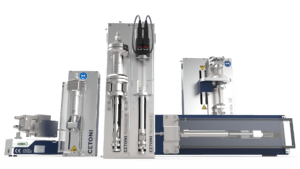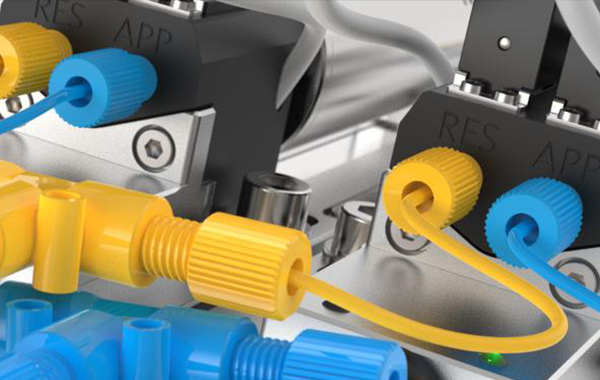In our #CETONIacademy section, we will start discussing the basics of micro-fluidics in regular intervals. The series starts with the term “pulsation-free”, because there is nothing more essential in micro-fluidics than a consistent flow of fluids.
So, what is “pulsation-free”?
The field of micro-fluidics is characterized by applications involving extremely small volumes of fluids in equally small cavities. Numerous applications, such as those found in flow-chemistry, require a steady, pulsation-free flow of fluids, to ensure continuous mixing ratios, even at very short time intervals. The creation and manipulation of compartmentalized flows in biochemical applications also demands such consistency.
In microfluidics, pulsations refer to oscillations of the actual flow rate, whereby the averaged flow rate can be absolutely correct. At extremely small flow rates, which often occur in micro-fluidic applications, pulsation can be strong, in relative terms, and have negative effects on small-scale processes. Even though mechanical components are incapable of delivering completely pulsation-free performance, pulsation can be reduced to such an extent that it can no longer be detected by existing measuring devices or ceases to have an influence on the application process at hand. This state is known as “pulsation-free”.

Pictures: Friedrich-Schiller-University Jena
Driving a car around a corner – with your eyes closed
Syringe pumps allow the volumetric transport of fluids through displacement, using a piston of a defined size, which moves at a defined speed. In order to generate a constant flow rate with a syringe pump, the lateral movement of the piston has to be extremely consistent. In this respect, conventional syringe pumps are often lacking, since the resolution of their drive section is limited. In turn, this leads to pulsation. However, the resolution of the pump’s measuring elements (encoder) is critically important.
The piston’s lateral movement must be generated by a controlled drive system. Commonly, the rotation of an electric motor is converted into linear movement by way of a spindle drive. A position controller checks the actual position or the motor’s rotation angle in regular, small intervals, and compares it with the respective target position. The deviation between actual and target value determines the amount of control necessary for motor, effected by manipulating motor current. A position sensor with a small resolution leads to longer measuring intervals, particularly at slow speeds. Therefore, the controller receives information on the actual position of the piston at relatively long intervals, which complicates control corrections and leads to speed fluctuations.

The following example will make this clearer. Imagine a control circuit, which stipulates that the driver of a car has to drive a certain distance, but may only open his eyes every two seconds in order to check his position and make course corrections. If the experiment is conducted on a straight track at a speed of 20 km/h, it will work reasonably well. However, if the driver has to go around a corner, the likelihood of success is strongly diminished. The vehicle’s path will probably resemble the shape of a polygon, rather than that of a curve, because, when opening his eyes, the driver will be compelled to make strong corrections to his position in order to stay on track.
Maximum Resolution – Maximum Quality
Low sampling rates in syringe drives lead to constant corrections, effected by increasing or lowering motor current. This prevents a smooth and steady operation. Pulsations arise. At CETONI, we therefore rely on the highest quality components and equip our syringe pumps with drives offering a resolution in the sub-micrometer range. As a result, the pulsation of our drives is so low that it does not play a role in the currently established microfluidic processes. Therefore, neMESYS syringe pumps are suitable for microfluidic applications with the highest precision requirements.

Our innovative spirit and the continuing miniaturization of chemical processes drives us to keep developing our micro-fluidic systems, instead of resting on our laurels. That is the only way to fulfill our mission and enable top-level research and development.




